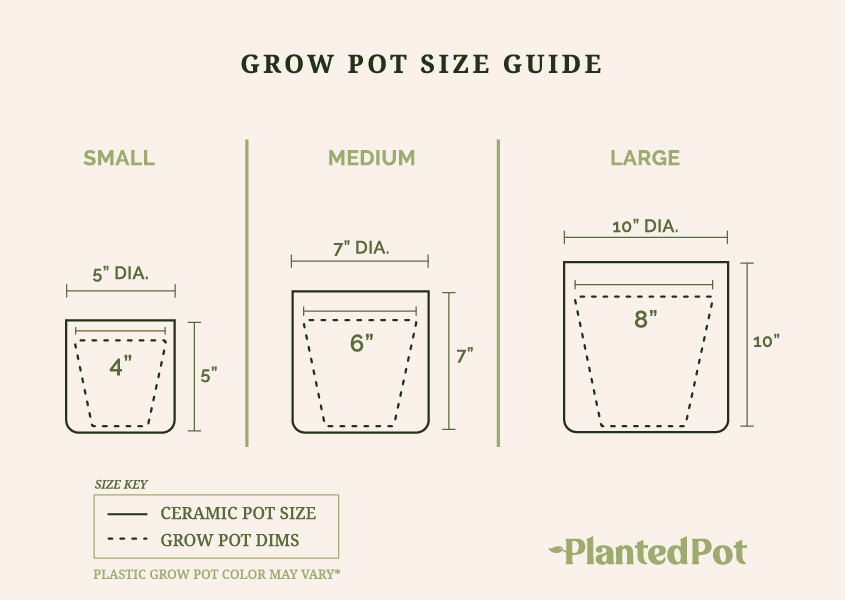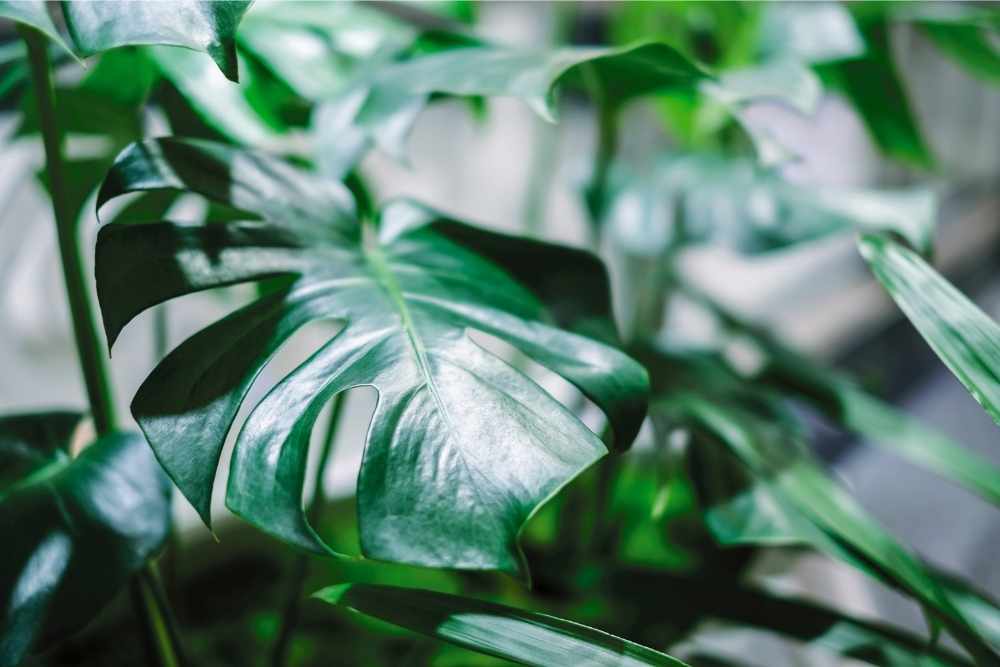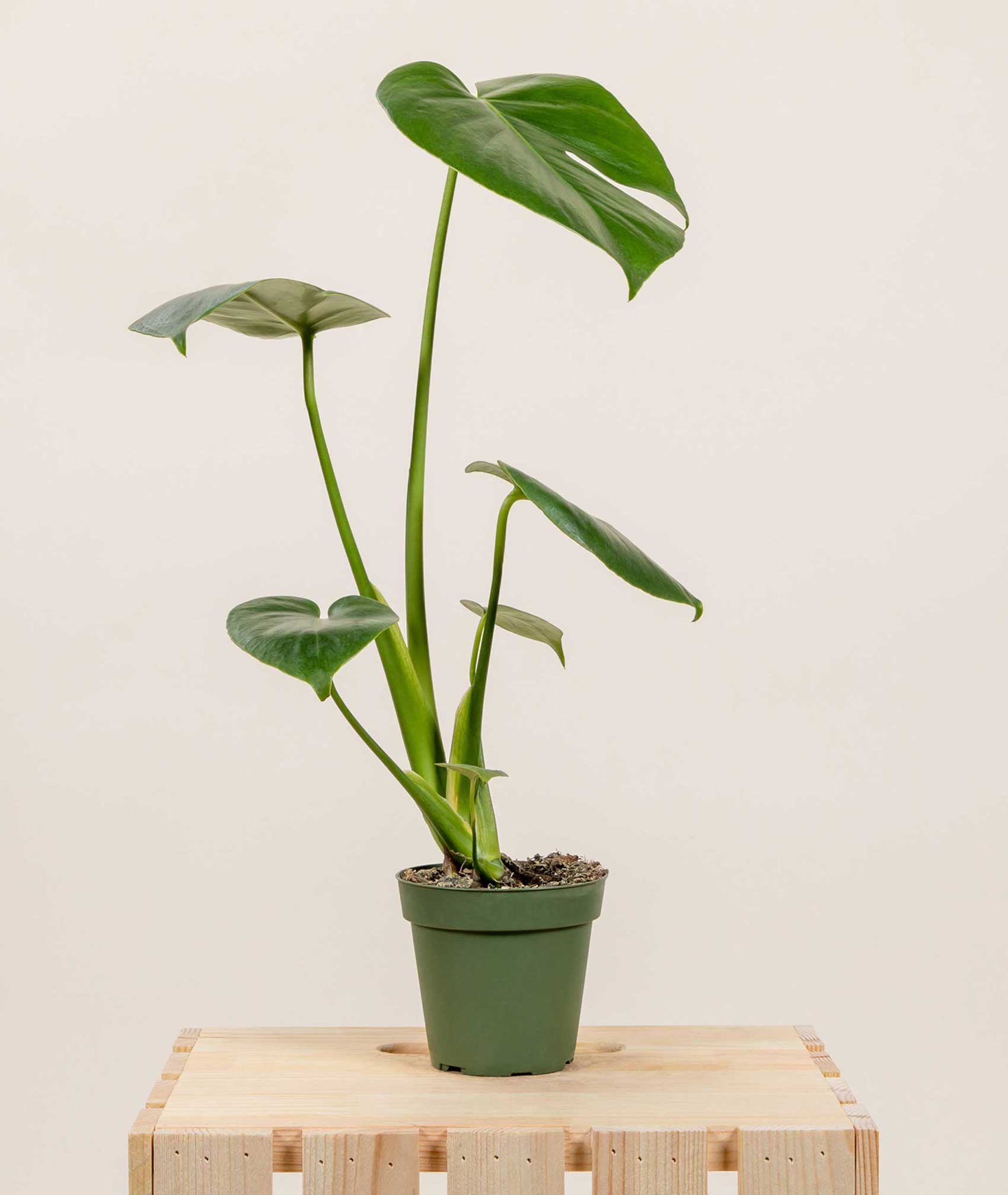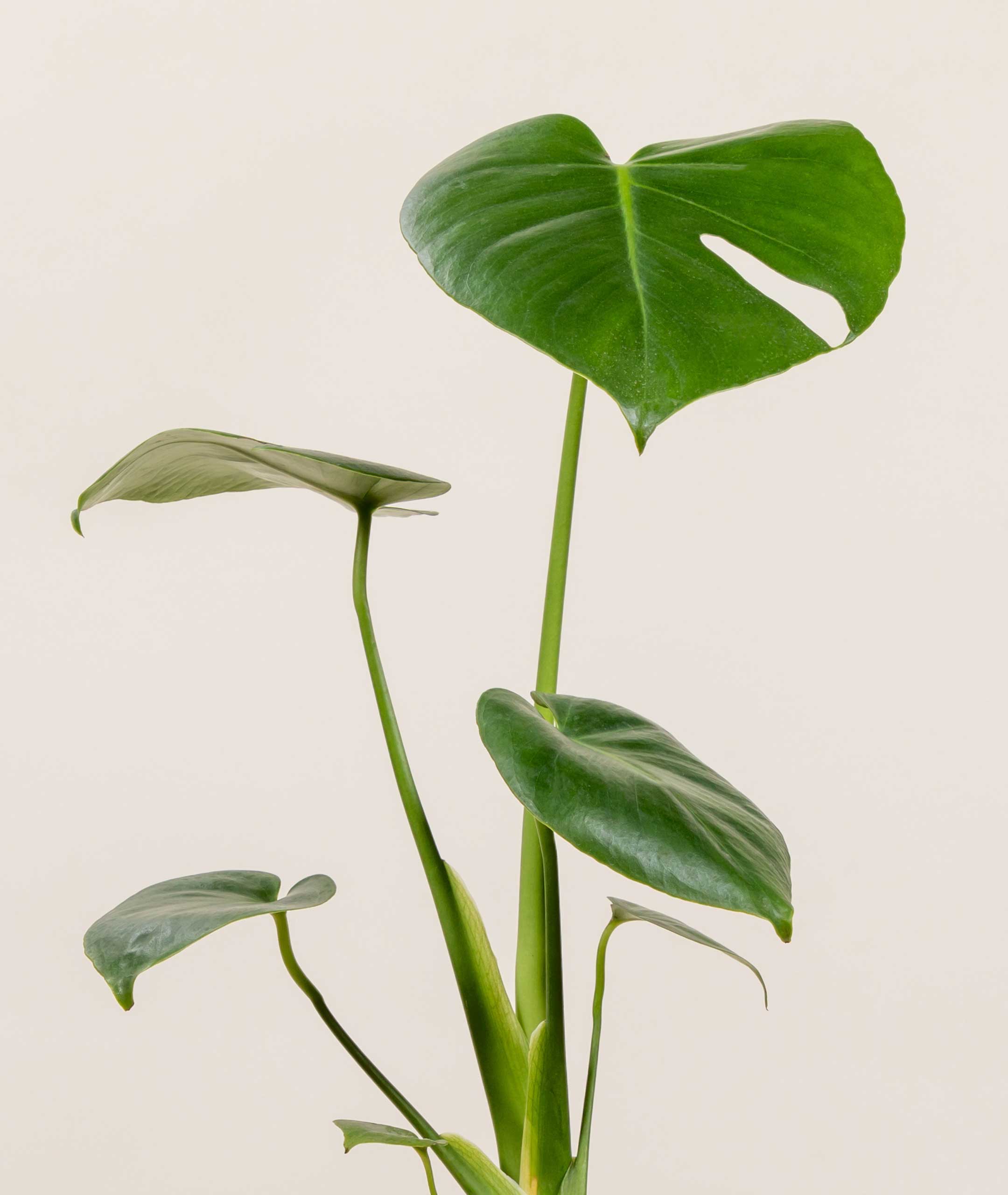
Monstera Deliciosa
$35
 Plastic grow pots come in different colors, you may receive a black or rust colored pot.
Plastic grow pots come in different colors, you may receive a black or rust colored pot.
The Monstera Deliciosa is an exotic tropical houseplant that will slowly spread into a majestic beauty with bold, jungly leaves. These large, shiny dark green leaves are artfully perforated like Swiss cheese, yet provide ample shade. In the wild, this unique, stately plant can grow dozens of feet tall and produce corncob-shaped fruit that tastes like pineapple, banana, and mango. Indoor care for a Monstera is easy — find a spot with indirect sunlight that will allow it enough space to stretch out. Weekly watering and a fairly humid environment are ideal. If you don’t have enough room for the mature Monstera, you can trim a few stems and enjoy the elegant leaves in a vase.
Bright indirect sunlight, partially shaded. Avoid direct strong sunlight but put indoor plants outside at least once a year in direct sunlight to encourage lush growth
Give the plant regular waterings during the growing season. The soil will need to dry out slightly in between. Water only occasionally in fall and winter.
Consistently between 65 and 75 degrees Fahrenheit
Related Products
Monstera Deliciosa is a tropical plant known for its edible fruit, massive size, and naturally-forming holes in its leaves. These three traits are responsible for the plant’s unique names. “Monstera” refers to the massive size this species can reach, which is over 60 feet!
“Deliciosa” is Spanish for delicious, and it describes the tasty fruit that the species produces. Its other popular name, the “Swiss cheese plant,” is due to the holes that develop in its leaves. Nonetheless, the Monstera Deliciosa is a beautiful plant that makes a wonderful addition to any home, so let’s learn more about this beautiful plant with many names.
What is a Monstera Deliciosa?
Monstera Deliciosa is from the family Araceae, which is known for its monocotyledonous (grass-like) flowering plants. There are 45 plants in the Monstera genus, most of which are grown as houseplants. Monstera Deliciosa — charming and easy to care for — is the most popular species in its genus.
Many plant species don’t get fun, easy-to-pronounce names, but Monstera deliciosa is the exception to this rule. It is often confused with Monstera adansonii and Thaumatophyllum bipinnatifidum, which both feature wide, flat, hole-filled leaves. Both deliciosa and adansonii are called Swiss cheese plants.
Monstera Deliciosas is best known for the holes in their leaves. At first glance, you might think the plant’s owner isn’t watering or caring for their Monstera enough, but rest assured these holes are natural. Also called “eyes,” the purpose for the plants’ holes has been widely theorized by botanists.
One suggestion is that the holes allow the plants to withstand high wind speeds. The prevailing theory for why Monsteras (many species in the genus are pockmarked) have empty gaps in their heart-shaped leaves is that they allow the plant to spread out the surface area of its leaves.
Since this species is native to southern Mexico’s tropical forests, experts believe that Monsteras use holes to maximize the amount of sun a single leaf can catch. These holes allow the plant to cover more area without spending energy, creating an entirely new leaf.

What Does Monstera Deliciosa Mean?
Even though these plants are native to Mexico, and “deliciosa” is the feminine form of the word delicious in Spanish, Monstera Deliciosa is not a Spanish name. “Monstera” derives from the Latin word monstrum, meaning monster.
Monstera Deliciosa gets its name for two reasons: The first is its potential to reach an enormous size in the wild, with some plants reaching 65 feet in height. Don’t worry about your houseplant overgrowing your home, though, because indoor Monsteras typically grow to 10 feet.
While 10 feet is still impressive for a houseplant, it reaches a larger size in the wild because it uses trees to amplify its growth. Monstera Deliciosas will start growing at the tree’s base and steadily climb up it to reach the light at the top of a forest’s canopy. It does this using special roots.
We’re all familiar with how a plant lays its roots in the ground to soak up nutrients and grow taller. Some species — such as the Monstera plant — have aerial roots that grow above ground. They search for opportunities to climb higher and are responsible for the plant’s “Monstera” name.
We’ll take a closer look at Monstera Deliciosa’s fruit further on in this article, but it is why the plant was initially cultivated. These big and fruit-producing plants have rightfully earned their name: Delicious Monsters!
Where Do Monstera Deliciosa’s Come From?
Monstera Deliciosa thrives in humid tropical regions, and it is native to Central America, though some plants of this species are in North America, Asia, Australia, and the western Mediterranean. In Central America, the plant is common in southern Mexico, Panama, Belize, Honduras, El Salvador, Costa Rica, Guatemala.
Monsteras were introduced to Hawaii and have since become a widespread plant in the Aloha State. It is so well-suited to the tropical climate of Hawaii that it has become a mildly invasive species. It is not known when or how the plants came to areas like Hawaii and England.
The early history of the Monstera plant is largely unknown because indigenous Central American people had likely cultivated Monsteras for hundreds if not thousands of years before Deliciosas were widely known. By the late 1700s, the plant’s fruit was being cultivated in England.
The plant’s murky origins are also due to its confusion with other plants that are similar in appearance. The spread of Deliciosas outside Central America could be the result of birds carrying seeds to other countries. It could also be due to people all over the world using Monsteras to decorate!
Do Monstera Deliciosa’s Have Benefits?
The Monstera Deliciosa is a fast-growing houseplant, and rapid growth means plenty of consumed nutrients. This plant sucks up carbon dioxide in the surrounding air and turns it into clean oxygen. The Swiss cheese plant is perhaps the best-looking air purifier available!
These houseplants love plenty of water in the air. If you live in a dry environment, Deliciosas humidify the air through a combination of the oxygen they release and a process called evapotranspiration. Through evapotranspiration, water moves through the plant’s roots and out of its leaves, releasing in the air.
Taking care of plants is beneficial for many other reasons, including:
- Improved mood
- Uplifts mood
- Reduced stress and unease
- Minimizing headaches (through improved air quality)
- Moisture in the air is good for skin and breathing conditions such as asthma.
Studies have shown that plants soothe our minds and mood by reconnecting us with nature. Like a plant survives best in a green habitat, we humans are at ease when surrounded by nature. Research has even suggested that a plant may improve focus and attention levels.
With Monstera’s broad leaves and love of humidity, you can expect to see these benefits. Since dry air can often exacerbate conditions like asthma, having this plant in a living area can reduce the chance of damaged lungs. The Deliciosa is not recommended for those whose breathing issues are bothered by air moisture.
Monstera’s Vs. Split Leaf Philodendron’s: What’s the Difference?
The Monstera Deliciosa gets mistaken for the Thaumatophyllum bipinnatifidum, or the Split Leaf Philodendron for many reasons. Both are in the Araceae family, and though they may look similar, they are not the same plant. As if things weren’t confusing enough, both share the nickname of Swiss cheese plants!
The primary difference between these two common houseplants is their leaves. Philodendrons are vines that spill over their planters toward the floor, while Deliciosas and their aerial roots try to reach as high as possible. The Philodendron’s leaves resemble a fringe trim, while Monstera’s leaves have heart-shaped leaves.
Philodendrons are closer to pothos (Devil’s Ivy), while Deliciosas are more similar to peace lilies. Technically, the name “Split Leaf Philodendron” has not been accurate since 2018. Philodendron is a broad genus that formerly contained three subgenera: Meconostigma, Pteromischum, and Philodendron.
The Split Leaf belongs to Meconostigma, but in 2018 that subgenus moved into its genus, called Thaumatophyllum. This change in the genus was necessary because Thaumatophyllum is not as closely related to Monstera as its previous genus: Philodendron.
Can You Grow a Monstera Deliciosa Plant at Home?
Absolutely! Anyone can grow a Monstera Deliciosa at home because it is such an easy plant to care for. These are some common reasons that people choose to keep Deliciosas:
- They are low-light plants.
- Don’t need excessive watering.
- Don’t need special soil (we recommend peat-based potting soil).
- They thrive at room temperature (65-85°F).
Keep deliciosas in rooms that get bright, indirect light. A sunny room is perfect for this tropical plant, but avoid placing them in the way of direct sunlight. Since these plants grow in tropical forests where vegetation has to compete for light, too much may burn them.
Water Deliciosas every one to two weeks. The soil can dry out between watering periods, but keep in mind that the growth of these plants depends on the amount of light they receive. The more light Deliciosas get, the thirstier they will be.
Try to keep this plant away from your pets. Eating a leaf can be toxic to pets and humans due to its calcium oxalate content. Fortunately, it isn’t fatal, only causing mouth and stomach irritation.

Do Monstera Deliciosa Produce Fruits?
Monstera Deliciosa produces a delectable fruit that is safe to eat for humans. Its long and cylindrical shape resembles a green ear of corn. Though, the flavor of the Monstera’s fruit is similar to a banana, mango, and pineapple.
Feel free to check your plant for fruit, but indoor varieties of Deliciosas rarely grow these sweet treats. Monstera’s fruit can be hard to find outside of its native countries, but who knows? You may get lucky and find one in your plant’s pot someday!
If you happen to come across the Monstera’s fruit, you’ll have to wait ten months before it is ripe. Even though we’ve enticed you with the delicious flavors they possess, resist the urge to bite into unripe fruit. It may still contain toxic levels of calcium oxalate, which can irritate our bodies.
Final Thoughts – Monstera Deliciosa
The Monstera Deliciosa is a beautiful plant anyone can grow. It doesn’t need intense care to live a long time, making it the ideal indoor houseplant. As long as you provide it with bright, indirect sunlight, a peat-based growing medium, and weekly waterings, your plant will thrive for years to come!





Reviews
There are no reviews yet.